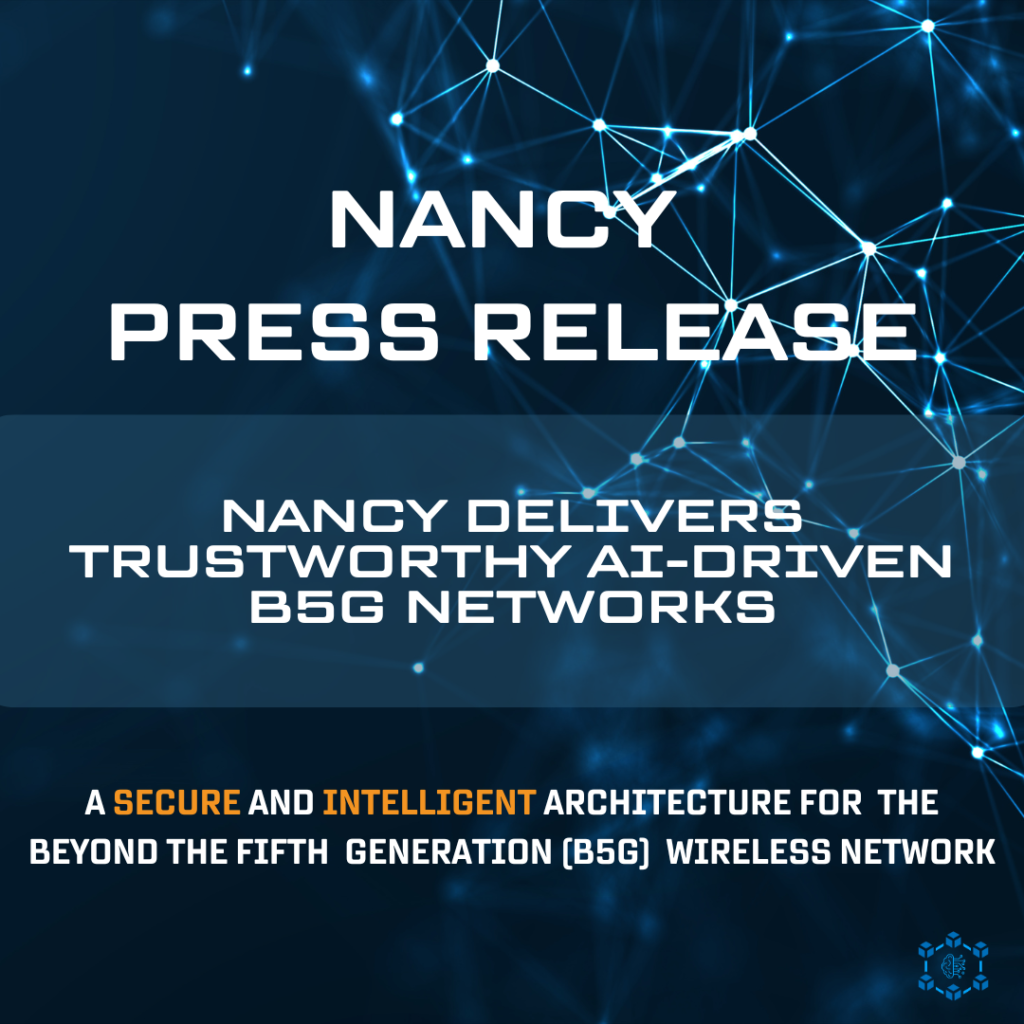The NANCY project is rethinking how next-generation (Beyond 5G) networks are built, putting security, efficiency, and trust at the center of tomorrow’s connectivity.
Instead of relying on centralized systems, NANCY uses Blockchain-based radio access networks (B-RAN) and artificial intelligence to make networks more transparent, secure, and adaptable. This means safer and faster connections for emerging applications like augmented reality, autonomous vehicles, and massive IoT deployments.

What’s new in NANCY?
- Smarter networks: NANCY developed AI-powered tools that can predict coverage, detect outages, and manage network latency with high accuracy.
- Greater security: New models show how to defend against major cyberattacks, ensuring that next-gen networks remain trustworthy.
- Efficient performance: Reinforcement learning techniques automatically optimize resources, reducing costs for providers while improving user experience.
- Hands-on tools: NANCY’s Network Information Framework (NIF) offers an easy-to-use platform for engineers and researchers to test and fine-tune network performance.
Why it matters
As our world becomes more connected, networks need to handle massive demand while staying secure and cost-efficient. NANCY’s results pave the way for a future where citizens can even act as connectivity providers, making networks more flexible and resilient.
Telecom operators, the ICT industry, and society at large all benefit:
- Lower operational costs and new services for providers
- Faster time-to-market for innovative products
- Reliable, energy-efficient, and low-latency connectivity for citizens and industries
“Beyond just theory – NANCY’s AI-powered tools are making secure, efficient B5G systems a reality that has the potential to transform connectivity worldwide.”
— Dr. Stylianos Trevlakis (Technical Manager), InnoCube P.C.
See it in action:
Check out our B-RAN theoretical modeling demo: Watch here.
Further Reading:
- S. Trevlakis, et al. “Localization as a key enabler of 6G Wireless Systems: A comprehensive survey and an outlook,” in IEEE Open Journal of the Communications Society, Oct. 2023.
- E. Koutsonas, et al. “A Deep Learning Mobility Management Approach for RIS-Empowered Millimeter Wave Wireless Systems,” 2023 IEEE Virtual Conference on Communications (VCC), pp. 177-182, NY, USA, 2023.
- J. Zhu, et al. “Rate-Splitting Multiple Access With Finite Blocklength and High Mobility for URLLC Transmissions,” in IEEE Wireless Communications Letters, vol. 13, no. 5, pp. 1518-1522, March 2024.
- S. Kurma, et al. “URLLC-Enabled Full-Duplex Cell-Free Massive MIMO Systems With Mobility,” in IEEE Open Journal of the Communications Society, vol. 5, pp. 3196-3211, May 2024.
- M. Belesioti, et al. “Beyond 5G networking: the case of NANCY project”. 2024 IFIP International Conference on Artificial Intelligence Applications and Innovations, Springer Nature Switzerland, pp. 19-32.
- K. Kaltakis, et al. “A Reinforcement Learning-Based Reverse Auction Enforcing Smart Pricing Policies towards B5G Offloading Strategies”, Electronics, 13(13), 2488, 2024.
Stay up to date with NANCY’s results and upcoming demonstrations:
- 🌐Website: https://nancy-project.eu
- 📺Youtube: @nancy-snsju-project
- 💼LinkedIn: @nancy-snsju-project
- 🐦X (Twitter): @NANCY_snsju
- 📘Facebook: @NANCY.SNSJU.Project
NANCY is a Horizon Europe project funded by the Smart Networks and Services Joint Undertaking (SNS JU). NANCY brings together 24 partners from 9 European countries to design a secure, intelligent, and energy-efficient architecture for Beyond 5G (B5G) networks.
The project has received funding from the Smart Networks and Services Joint Undertaking (SNS JU) under the European Union’s Horizon Europe research and innovation programme under Grant Agreement No 101096456. Views and opinions expressed are however those of the author(s) only and do not necessarily reflect those of the European Union or SNS JU. Neither the European Union nor the SNS JU can be held responsible for them.







